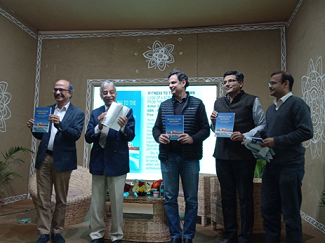Researchers are trying to mimic biological principles to develop new engineering solutions for medicine, industry and the environment. The approach combines life sciences with engineering and the physical sciences.
In case of lotus leaf, beaded water droplets readily roll off on slight tilting of the interface. Such super-hydrophobicity of lotus leaf has inspired researchers to develop products or synthetic materials with extremely liquid water repelling surface that could meet real world challenges.
Researchers at Indian Institute of Technology-Guwahati have provided a strategy for self-healing and super-hydrophobic coating which might simplify the process of protecting surfaces from water. The finding has been reported in scientific journal Chemistry of Materials.
“Our aim was to synthesize substrate independent coatings with highly durable bio-mimicked wettability—which would be capable of performing on severe conditions. Synthesis of such material is unprecedented in literature. We have got some promising results,” said Dr Uttam Manna, who led the research.
Dr. Uttam Manna (right) with Avijit Das
" Our research interest is to develop self-healing and robust bio-mimicked interface which would be useful in many diverse outdoor energy and healthcare related applications "
The synthetic super-hydrophobic material could provide a general platform to design materials for widespread applications including self-cleaning, oil-water separation, water harvesting, guided water transfer, drug release, drug screening etc.
Researchers formulated Amino-graphene oxide (AGO) 2D Nano sheets--which are well known for its exceptional mechanical property in the reactive and porous polymeric coatings. The covalent integration of this AGO makes polymeric coating elastic, and eventually makes it capable of self-healing pressure induced by physical damage.
On the other hand, 'chemically reactive' and porous polymeric coating allowed to tailor the essential chemistry and topography - three dimensionally - in the material and provided robust bulk super-hydrophobicity.
Researchers have also tested polymeric coating for various physical stresses to check the durability of the embedded antifouling property of the synthesized materials. They claim that the current design is highly durable and has absolutely self-healable super-hydrophobicity without requiring any external stimuli.
Most often, such interfaces suffer from poor durability under diverse circumstances. “Our research interest is to develop self-healing and robust bio-mimicked interface which would be useful in many diverse outdoor energy and healthcare related applications,” said Avijit Das, first author in this study. Since the synthesized coating is capable of withstanding various physical damages without any external interventions, it could find commercial applications in future.
The research team included Avijit Das, Jumi Deka, K. Raidongia and Uttam Manna. The work was funded by the Science and Engineering Research Board (SERB) of the Department of Science and Technology (DST) and the Board of Research in Nuclear Sciences. (India Science Wire)


